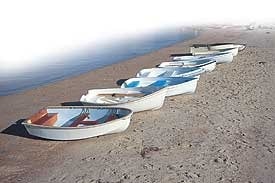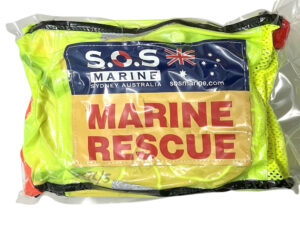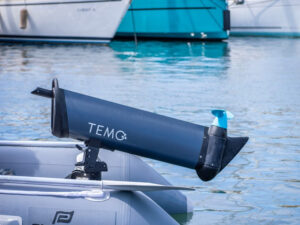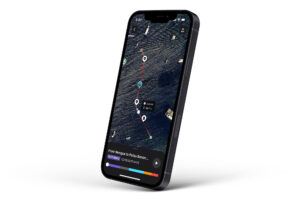
cw_9609.jpg
At a time when it seems everyone is packing RIBs or roll-up inflatables on board, why are cruising icons Lin and Larry Pardey, arctic adventurer Alvah Simon, Cruising World technical editor Ralph Naranjo, sailing writers Dave and Jaja Martin-all circumnavigators-and many others with miles and years beneath the keel so quick to praise the virtues of the seemingly archaic rigid dinghy? Because they take a beating and they work, no matter what.
In the October 2003 Cruising World, we tested rigid inflatable boats (RIBs). In the November 2003 issue, we examined roll-up inflatables. In the final installment of our boat-tender review, we look at 14 different hard dinghies, boats that will find special favor among cruisers who put simplicity and durability above all else.
During our 11 years of cruising with a homemade fiberglass dinghy, my wife, Theresa, and I rarely wished we’d had a fast inflatable or RIB. Talk to other hard-dinghy owners, and they’ll give many reasons for their preferences. A hard dinghy keeps you fit, has personality, can be rigged with a sail, is economical to buy and maintain, and, perhaps most important, can always be quickly deployed to set a second anchor or to kedge off a shoal.
If you’re convinced that a hard dinghy fits your lifestyle, here are key points to consider when choosing a model:
Size: Performance improves as waterline increases; the only real penalties for going big are added weight or lost deck space. Get the longest dinghy that you can safely fit on board and that you can drag up a beach by yourself.
Fit: Ideally, the tender should fit low on the deck overturned under the main boom or, on larger boats or center-cockpit boats, on the fantail. Davit stowage is fine for coastal hops but risky crossing oceans. Also check how thwarts and centerboard trunks fit over such deck features as hatches you may want to open for ventilation when the dink is overturned. Stability: Generally, beamier boats with flatter bottom sections have more initial stability up to about 15 degrees of heel, but rounded hulls will be stiffer when heeled more than that. For those who want inflatable-like stability in a hard dinghy, consider flotation collars like Dinghy Dogs (401-295-8382, www.dinghydogs.com).
Weight: For two- and three-person dinghies, aim for about 130 pounds or less, still light enough for one person to drag above the high-tide line. Many models are much lighter than this, all the better for your back. Manufacturers’ listed weights tend to be optimistic. See the boat, or a sister ship, and heft it yourself.
Rowing efficiency: For good performance, lightness is less important than an efficient underbody and trim when loaded. A fine bow, long waterline, canoe underbody, and minimal wetted surface are your biggest assets-but these all come with trade-offs. The slicker, stiffer hull bottoms of fiberglass boats offer less drag than the softer hulls of plastic or polypropylene boats. Except where noted, all of the boats below performed fine with one or two people aboard.
Thwart type: Centerline seats and two rowing stations allow the rower to easily shift position according to the load. A traditional thwart across the middle allows you to better stow the usual cargo. On boats with middle thwarts, you can usually add a forward set of oarlock sockets and, if needed, a removable centerline seat between the forward and center thwart to achieve proper trim with two people aboard.
Towing: Typically, either a fine full-length keel or a vestigial keel (skeg), or both, help to keep boats tracking straight. The trick is to minimize drag. If the boat tilts far aft off of its lines when towed, it’s probably inducing some extra drag. An Andersen self-bailer (available through West Marine and other marine retailers) or a similar device is worth having if you plan to tow the boat often.
Oars: Oars should be at least 6 1/2 feet long; many people prefer 7 feet or longer. In any case, make sure the oars fit inside the dinghy. Wood is the best choice (lightweight spruce is excellent) for cruising sailors. Chafe protection in the form of buttons and leathers is essential.
Oar locks: Most owners (including me) prefer round oarlocks held captive on the oars by retainers or the buttons (the leather strips that surround the inboard side of the leathers). Others prefer the traditional horn type. Take your pick, but carry a spare.
Buoyancy: Traditionally, builders achieve the essential positive buoyancy by putting airtight flotation chambers in the bow and stern seats. Other boats use foam between an inner liner and hull. The latter adds strength and allows for more stowage space but can increase weight. Sailing performance: This is a nice, but not essential, feature. You simply can’t expect screaming reaches from an 8-footer designed for the more important job of ferrying people and provisions. Nevertheless, a sailing rig expands your horizons and can be a real blast for the kids on board, particularly when other sailing dinghies are in the anchorage.
Other options: The list of options on many tenders is fairly long and can add substantially to the price of the boat. Many of them, like teak trim and floorboards, look nice, but unnecessarily add weight and maintenance. Key options to consider are the rubrail (particularly important), lifting eyes or harnesses (sometimes custom-fitted for davits), and a self-bailer or drain plug (essential for davit-stowed dinghies).
**
The Boats**
We tried to narrow the field to 8- to 9-foot boats, a size that’s big enough for a couple but still small enough to fit on the deck of most cruising boats. Although this wasn’t a formal test, I or one of our writers-some of whom know the boats intimately-was able to row and take a close look at all of the listed boats except the Gig Harbor Nisqually, a late entry into the field, and the NN 10, which wasn’t available in time. However, we did get input from owners of the Nisqually, and we were able to test Barry Niccolls’ latest creation, an 18-foot schooner that splits into two identical dinghies and shares many common features with the NN 10. Sailing rigs are optional for these dinghies, but we weren’t able to sail every one. Any mention of a boat’s sailing ability or towing characteristics is based on comments from one or more owners.
Trinka 8: Johannsen Boat Works, in Vero Beach, Florida, has earned high regard for its 8- and 10-foot Trinkas designed by Bruce Bingham. A great all-around performer under oar, power, or sail, the 8-footer is marked by a high freeboard and plumb bow. Cruising World writers Beth A. Leonard and Evans Starzinger, who carried a Trinka (and no outboard) with them during their first circumnavigation, extol the boat’s ruggedness. “The Trinka is a joy to row, bulletproof in construction, and pretty to boot,” said Evans.
Virtues: Johannsen’s selection of smart options makes this dinghy highly customizable.
Vices: Quality construction, joinery, and hardware make the Trinka one of the more expensive boats in this group.
Walker Bay 8: A bargain buy and virtually indestructible, the Walker Bay 8 (also available in a 9-foot-6-inch version, the Walker Bay 10) answers the call for an affordable hard tender that can truly take a beating. Constructed of high-impact plastic in an injection-molding process, the Walker Bay manages a salty look with a lapstrake design that adds stiffness. For a couple of weeks last summer, I literally knocked around the cliffs, seawalls, and oyster bars of Narragansett Bay in a friend’s Walker Bay 8 with only scratches to show for it. The Walker Bay needs virtually no maintenance except for the occasional scrub. A Classic version comes with teak floor grating, stainless-steel oarlocks, and a heavy-duty nylon rubrail.
Virtues: A feathery 71 pounds, the Walker Bay is truly a snap for one person to manhandle.
Vices: The standard plastic oarlock socket wears oblong with use; upgrade to metal.
Walker Bay RID 9: For those people who like the Walker Bay’s value and durability but wish they had the load-carrying capacity and stability of an inflatable tender, the Walker Bay RID (rigid inflatable dinghy) is the answer. Incredibly stable, the Walker Bay RID 9 is the Walker Bay 8 with an inflatable PVC tube fitted along the gunwale. A larger, 10-foot-2-inch RID (the Walker Bay 10 fitted with tubes) is also available. Putting a rubber collar on a hard dinghy isn’t a new idea, but by using a tube that varies in diameter and shape, the Walker Bay RID is the first such boat I’ve seen that still looks good. And it works: I could stand on the gunwale without getting my feet wet.
Virtues: Load the RID to the brim with no worries. Although the tubes add 18 pounds, the boat’s still much lighter than others its size.
Vices: The tubes will add drag in wind and chop, slowing the boat when loaded or sailing.
Whitehall Minto: Whitehall Reproductions, in Vancouver, British Columbia, specializes in replicas of the original Whitehall boats, a working gig design most prevalent in 19th-century Boston and New York harbors. The 9-foot fiberglass Minto rows exceptionally well. We made good headway with three adults on board, even in a mild chop. A fine bow gives way to flat hull sections, so the boat remains stable during boarding. Although freeboard amidship is less than others in this group, it still provides a dry ride in chop.
Virtues: As much a museum piece as it is a workboat, the beautiful Minto excels in quality teak joinery and bronze hardware.
Vices: The rope rubrail is tougher to keep clean than the other types.
American Sail Trihull: With 42 years behind it, South Carolina-based American Sail has a good sense of what works. Slap a 2-horsepower engine on this tri-hull, and it’s just what you need when it comes to hauling people and provisions. Just shy of 4 feet wide at the bow, the tri-hull affords maximum stability and payload capacity in a boat of this size. And with double-hull construction, foam flotation in the bow, stern, and gunwales, a nonskid interior, and rugged vinyl rubrail all standard, the boat stands up well to beaching and banging.
Virtues: For the avid diver, this is probably the only 8-footer you can comfortably flop into with your fins on. Its low profile (15 inches high) fits well under most booms.
Vices: Sailing isn’t an option, although American offers another 8-foot tender in a sailing version.
Bauer 8: All three Bauer models (at 8, 10, and 12 feet, respectively) maximize hull volume with plenty of beam, generous freeboard, and flotation foam in an interior liner. The sweeping sheer and high bow are obvious when you line up the Bauer 8 beside other dinghies its size. A U-shaped bench seat aft allows the helmsman to steer from a more natural position when sailing or motoring and leaves plenty of room underneath for storage. The centerline thwart ensures perfect fore-and-aft trim and has a watertight compartment for keeping small items safe and dry.
Virtues: A little boat with big-boat features, the standard Bauer has minimal wood to worry about, although a teak-trim package is available for those who want it.
Vices: The hull’s buxom shape and an inner liner make it slightly heavy for its size.
Boatex 8: Ontario-based Boatex makes four different moderately priced tenders (rowing or sailing) between 7 and 12 feet. The 8-foot-3-inch rowing/sailing tender we looked at had an optional navy-blue sheer strake, which highlighted the Boatex’s graceful sheer and the classic tumblehome. With a 54-inch beam, the boat is very stable for its size, and the fine full-length keel gives it excellent tracking ability. With virtually no exposed wood, the standard version manages to produce classic looks without adding to upkeep. Get the optional rubrail.
Virtues: The towing eye is a failsafe metal grommet installed laterally through the stem, leaving no hole into the hull or fasteners to fail. Vices: The hanging-thwart design leaves some hard edges and a few tough-to-clean nooks and crannies.
Dyer Midget: The 8-foot-1-inch hard-chine Dyer Midget is an offspring of the famous 9-foot Dyer Dhow. Today, The Anchorage in Warren, Rhode Island, builds the five evolutions of the Dhow up to 12 feet. For use on boats with low boom clearance, Dyer offers a “Lo-sheer” version of the Midget that’s just 18 inches high. Teak trim, patented bronze castings, a bit of leather trim, and Sitka spruce spars (in the sailing version) give the Midget’s pragmatic hull a traditional accent. Alvah Simon, who relied on a Midget during his 13-year circumnavigation, had these high compliments: “It’s featherlight, very strong and durable, and stable enough for diving; it has enough of a forefoot and keel for it to tow well.”
Virtues: Any design that’s stood the test of 70-plus years has got to be good.
Vices: The large, flat floor panels will flex, but for many, this is a fair trade-off for lightness.
Fatty Knees: The Lyle Hess-designed Fatty Knees comes from Edey and Duff, a Massachusetts builder of distinctive boats with character, including Sam Crocker’s Stonehorse sloop. Available in 7-, 8- and 9-foot versions, the Fatty Knees looks a bit pudgy in plan view, but its modest sheer, prow bow, judicious use of teak and bronze, and lapstrake hull add a classic dimension to a very functional hull form. In the right hands, she’ll handle chop with aplomb when loaded full of people or provisions. As for durability, cruising icons Larry and Lin Pardey have put two decades into their 8-foot Fatty Knees and have lavish praise for the tough little boat.
Virtues: Two rowing stations ensure proper rowing trim with one to three people aboard. The offset (to port) motor mount allows enough room to steer from the aft seat.
Vices: The T-shaped centerline thwart may take some getting used to.
Gig Harbor: Located in Gig Harbor, Washington, Gig Harbor Boatworks has for 30 years been adapting proven workboat designs. In its eight-boat line, at least three models, the 7-foot-11-inch Nisqually, the 9-foot-6-inch Captains Gig, and the 10-foot Navigator Dinghy, could be suitable tenders. The Nisqually is a scaled-down version of a utility boat commonly rented out for recreational purposes during the 1890s. The optional Kevlar-reinforced version of the Nisqually, cored with Klegecell foam, is exceptionally light and strong; the heavier, solid-fiberglass version is still quite light thanks to its single-skin lapstrake construction. The low-maintenance Nisqually, a capable rower, sailer, and powerboat, is a true multipurpose dinghy.
Virtues: Lightness and low maintenance are hallmarks of the Nisqually. Vices: Gig Harbors are built one at a time, so don’t expect overnight delivery.
**
HunterLiberty:** In building the 10-foot-2-inch Liberty, which Hunter Marine introduced last year, large extruded sheets of a rugged plastic are superheated until pliable, then vacuum-pressed onto the molds, one for the hull, another for the hull liner. Flotation foam backed by fiberglass mat is added on the inside of the hull and liner before the two parts are joined. The stiff, virtually unsinkable hull looks and feels like fiberglass but has five times the impact resistance and none of the gelcoat-maintenance worries. With lean, Whitehallish styling and a fine bow, the Liberty is an excellent rower and is light enough for a couple to handle easily.
Virtues: The revolutionary production process permits an attractively low price.
Vices: The ultra-slick hull will need some nonskid pads for better footing.
NN 10: Searching for a hard dinghy to fit on his Coronado 27, entrepreneur and avid cruiser Barry Niccolls came up with a fairly narrow 10-footer that could be separated into two halves, with the 40-pound bow section nesting inside the 60-pound, 5-foot-8-inch-long aft section. Either half has enough foam flotation in sealed thwart chambers to float on its own. Normally, you attach the two halves in the water from a kneeling position in the aft hull. Stainless-steel latches and a special fastening system make joining the two bulkheads quick and easy. Rubrails made of PVC hose and the polyethylene seats reflect the boat’s utilitarian priorities.
Virtues: You get a bigger dinghy without sacrificing the deck space or having to heft 110 pounds or more at a time.
Vices: The production rate is limited, so you can expect to wait three months or more.
**
Portabote:** For three decades, Portabote has built a loyal following with its unconventional folding boats made of flexible polypropylene. The company makes four models that range from 8 feet 6 inches to 14 feet 6 inches, each of which folds into a package that’s slightly longer than its length, less than 25 inches wide, and about 4 inches thick. The 12-foot-6-inch model we tried can stow folded on boats that normally would carry much smaller dinghies. A sailing kit is available, but this planing-hull design works best with a motor.
Virtues: Despite (and partly because of) the flexing hull, it’s stable enough to waltz in.
Vices: The standard oar setup leaves much to be desired; convert to traditional oars and oarlocks if you plan to row.
Puffin 8: Frankfort Boat Works, in Frankfort, Maine, offers three models of its Puffin in lengths from 7 feet 6 inches to 10 feet 6 inches, with a sailing-rig option available for the two larger boats. The 8-foot-6-inch model we tried is typical of the good-looking, utilitarian tenders you’ll see in Maine, where “pulling” for work or pleasure is part of the fabric of life. This single-skin fiberglass vessel struck us as a nice compromise of weight, appearance, performance, and price. Long, flat sections and adequate beam make it a stable boat for its size. It’s light enough for two people to manage yet built to take the knocks that Maine’s rocky shore can dish out.
Virtues: A hollow PVC rubrail and only a smattering of wood trim keep maintenance hassles down. The grip of the buff-colored nonskid surface is excellent, even when wet.
Vices: The price-point Puffin’s finish quality is a tad lower than the more expensive boats.
| Model | Length Overall | Max Beam | Draft/ Draft with Board Down | Load (persons/ weight lbs.) | Weight (pounds; without oars or sailing kit) | Sail Area (sq. ft.) | Max HP | Sugg. Price | Sailing Version | Contact |
|---|---|---|---|---|---|---|---|---|---|---|
| American Sail Tri-Hull 8 | 8′ 1″ | 4′ 3″ | 4″ | 3/450 | 95 | NA | 2 | $895 | $1,595* | (843) 552-8548, www.americansail.com |
| Bauer 8 | 8′ 2″ | 4′ | 4″/1′ 8″ | 3/465 | 95 | 40 | 2 | $995 | $1,800 | (904) 824-8826, www.bauteck.com |
| Boatex 8 | 8′ 3″ | 4′ 6″ | 4″/2′ 4″ | 3/500 | 75 | 40 | 3 | $1,075 | $1,795 | (905) 294-9454, www.boatexltd.com |
| Dyer Midget | 8′ 1″ | 4′ 1″ | 5″/2′ 5″ | 3/465 | 83 | 36 | 2 | $2,080 | $3,320 | (401) 245-3300, www.dyerboats.com |
| Fatty Knees 8 | 8′ 0″ | 4′ 3″ | 2″/3′ 3″ | 3/NA** | 100 | 50 | 2 | $1,995 | $2,945 | (508) 758-2743, www.fattyknees.com |
| Gig Harbor Nisqually | 7′ 11″ | 4′ 5″ | 6″/2′ 0″ | 3/NA** | 72 | 38 | 2 | $895 | $1,895 | (253) 851-2126, www.ghboats.com |
| Hunter Liberty | 10′ 2″ | 4′ 1″ | 6″/2′ 6″ | 3/371 | 105 | 45 | 3 | $1,200 | $2,025 | (860) 739-3033, www.huntermarine.com |
| NN 10 | 10′ 2″ | 4′ 5″ | 2″/2′ 0″ | 3/500 | 100 | 70 | 3 | $2,295 | $3,295 | (604) 218-8027, www.niccollslite.net |
| Puffin 8 | 8′ 6″ | 4′ 1″ | 5″/2′ 1″ | 3/425 | 75 | 39 | 3 | $920 | $1,790 | (207) 223-2273 |
| Portabote 12 | 12′ 6″ | 5′ 0″ | 4″/1′ 5″ | 4/670 | 69 | 52 | 54 lbs.*** | $1,395 | $1,990 | (650) 961-5334, www.porta-bote.com |
| Trinka 8 | 8′ 0″ | 4′ 0″ | 4″/1′ 6″ | 3/450 | 95 | 38 | 2 | $2,275 | $3,095 | (772) 567-4612, www.trinka.com |
| Walker Bay 8 | 8′ 3″ | 4′ 4″ | 2″/1′ 8″ | 2/425 | 71 | 39 | 2 | $630 | $1,280 | (604) 682-5699, www.walkerbay.com |
| Walker Bay RID 9 | 9′ 0″ | 5′ 8″ | 2″/2′ 7″ | 3/410 | 89 | 50 | 4 | $1,330 | $2,230 | (604) 682-5699, www.walkerbay.com |
| Whitehall Minto | 9′ 1″ | 4′ 2″ | 6″/1′ 10″ | 3/480 | 130 | 46 | 4 | $3,450 | $5,260 | 250-384-6574, www.whitehallrow.com |
- Sailing version is a different boat with traditional hull design.
** No capacity is given, since boat is rated as a sailboat.
*** Maximum engine weight is limiting factor.








